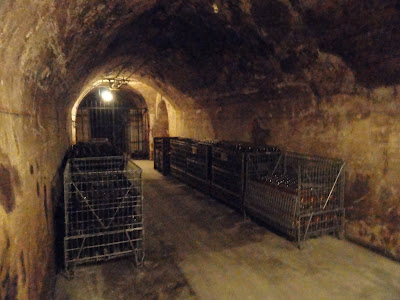There are plenty of fascinating items to learn and know about Champagne. Yesterday, I posted Ten Things You Should Know About Champagne but I quickly realized there were more items that you should know. So, here is a supplement to my original post, adding six more intriguing items about the realm of Champagne.
1) Champagne is versatile with most foods.
While touring the Champagne region, I drank Champagne with nearly every lunch and dinner. Steak tartare, cod, veal with morels, tomatoes & mozzarella, snails & pasta, cheese, chicken Milanese, and much more. The style and type of Champagne varied, dependent on the course, from bone-dry, no dosage cuvees to fruity Rosé Champagne. In general, the pairings went very well, the bubbles seeming to help cleanse the palate as well. It is probably rare for you to have Champagne with every course of a meal, yet it can be done and done well. It certainly would be a pleasant change from just pairing courses with still wines. Try Champagne with any type of food you have, and see what you think. Someone had to be the first person to try potato chips and Champagne, a pairing which works very well.
2) No dosage is a growing trend.
During the production process, after disgorgement, a liqueur de dosage, also known as a liqueur d'expedition, is added to the bottle. This dosage is usually a mixture of wine and sugar, and it helps to soften and sweeten the Champagne. The amount of sugar varies, and it will then determine the level of sweetness of the Champagne. Yet there is a growing trend in the Champagne region to produce "non-dosage" Champagnes, which have no added sugar.
One producer stated that this trend was partially brought about by the greater consumption of sushi in France as well as the slow food movement. Producers may warn as well that "non-dosage is not for beginners." This is because the non-dosage Champagne can taste highly acidic and bitter, and could turn off many people. Some producers are opposed to non-dosage, adding that it will not age well so needs to be drank very young. One producer even stated that "Champagne without dosage is like a woman without makeup." I tasted several non-dosage Champagnes, and most were very acidic though not unpleasantly so.
3) Terroir exists in Champagne.
It is a given that terroir exists in the Champagne region, that it possesses a unique profile of climate, soils, topography and more. The region is subject to a dual climate of continental and oceanic, and this combination often leads to excellent rainfall, producing sufficient water for the wines to produce excellent fruit. The subsoil is predominately limestone, gives good drainage and a particular mineral taste to the wine. Vineyards are generally planted at altitudes of 90-300 meters, mostly on south, east and southwest facing slopes. This terrain has many sites with good drainage and optimum exposure to the sunlight. So, one can say, though not all may agree, that all Champagne, even if blended, is reflective of the general terroir of the region.
But what about more specific terroirs, more individual plots of land? Certain villages are recognized as being better than others, thus the creation of Grand Cru and Premier Cru villages. So a Champagne which only uses grapes from Grand Cru vineyards may be more reflective of specific terroir. In addition, there are now some producers who are creating single-vineyard Champagnes. Yet there will probably always be a question whether blended Champagnes can express terroir or not. Terroir is somewhat of an elusive term, so its applicability to a wine or wine region may relate to your own specific definition of "terroir," especially how specific that definition becomes.
4) Champagne is often expensive.
I have ranted about this topic before, despairing at the lack of good Champagne under $30. That makes Champagne more elitist, more of a special occasion wine. Though it would be great to promote Champagne as an every-day drink, the cost prohibits most people from being able to do so. The price is also a reason why sparkling wines from the rest of the world are more popular in the U.S., because you can often purchase them much cheaper than good Champagne. Sadly, for many of the large Champagne Houses, the added bottle cost comes from all of their intensive marketing efforts. Grower's Champagne is often a much better choice because it is less expensive but usually possesses high quality. Growers don't have the high marketing costs of the Houses, so they can afford to charge significantly less for their Champagne. That is where you will find the best value Champagnes.
5) Rosé Champagne is usually a blend.
A Rosé can be produced by mixing red and white wines together but that is prohibited across all of France, except oddly enough in the Champagne region. In Champagne, such blending is the norm though some producers are now using the more universally accepted Saignée method. The saignée method, where pink juice is removed during the fermentation of red wine, is thought by some producers to impart more flavor to the Rosé. Out of the Rosé Champagnes I tasted, I preferred those produced using saignée.
6) Vineyard land in Champagne is expensive.
Land costs in the Champagne region are quite exorbitant, an average of $1-1.4 million Euros per hectare, or $1.4-$1.96 million US dollars. A hectare consists of about 2.47 acres and produces an average of 10,000 bottles of Champagne. In comparison, the cost of vineyard land in Napa Valley can range from $100K-$350K per acre, with some areas even more expensive. So, in general, Napa, which is usually considered an expensive locale for land is still less expensive than land in Champagne. These high land prices do contribute to the higher cost of their wines.







No comments:
Post a Comment